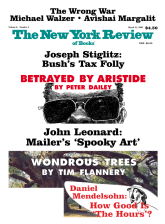To the Editors:
I welcome the review by Caroline Fraser [NYR, November 21, 2002] of two recent books on the Mormons’ role in the Mountain Meadows Massacre. She includes a survey of books published on the episode since 1857.
Your readers should know that the review does not mention one of the most reliable books on the subject: William Wise’s Massacre at Mountain Meadows: An American Legend and a Monumental Crime (Thomas Y. Crowell Co., 1976). This account goes deeper into Mormon history and draws on more non-Mormon and governmental sources than any of the titles surveyed by Fraser. After reading Wise, one finds little “mystery” and “obscurity” surrounding the events.
Because of the evidence Wise’s book assembles, the Mormons have been trying to bury it, with mixed success, ever since it appeared. Today, any competent Web search will bring up the title. Copies are newly available from iuniverse.com and from the Authors Guild’s backinprint.com.
The best single volume about this shameful, half-suppressed episode in American history must not be overlooked, either inadvertently or intentionally.
Roger Shattuck
Lincoln, Vermont
Caroline Fraser replies:
I am grateful to Mr. Shattuck for bringing William Wise’s Massacre at Mountain Meadows to my attention. But while Wise’s book seems a useful, if dated, popular account, I cannot agree that it deserves to be called “the best single volume” on the subject. It relies too uncritically on John D. Lee’s confessions (in Mormonism Unveiled) and too heavily on previously published works, such as Juanita Brooks’s The Mountain Meadows Massacre and John Doyle Lee. Despite that reliance, Wise is dismissive of Brooks, warning readers to treat her work “with extreme caution” because of “her…aim—to defend the Church’s reputation at any cost.” Given that Brooks was ostracized for life by her Mormon community after concluding that “the final responsibility [for the massacre] must rest squarely upon the Mormons” and declaring Brigham Young an “accessory after the fact” to the crime, such a charge, presented without qualification, seems unfair, as well as inaccurate.
Also inaccurate is Mr. Shattuck’s assertion that Wise employs more “non-Mormon and governmental sources” than any of the books reviewed. Will Bagley’s bibliography in Blood of the Prophets: Brigham Young and the Massacre at Mountain Meadows is more extensive, varied, and comprehensive than Wise’s. For example, Bagley cites forty-six period newspapers; Wise cites nine. Mr. Shattuck’s implication that “non-Mormon” sources are inherently more reliable or valuable than Mormon ones is also puzzling, since materials from the Archives of the Church of Jesus Christ of Latter-Day Saints—particularly the papers of Brigham Young and his Indian interpreter, Dimick Huntington, cited extensively by Bagley (and not at all by Wise)—are essential in understanding this historical event.
This Issue
March 13, 2003



